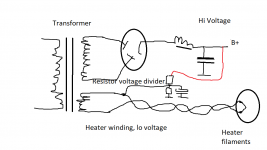Hope you get this fixed, a beautiful piece of kit, tho way too much gain in my little opion. I'd just skip the 6SN7 stage all together.
Anyways, to me the problem is very suspect of heater filament to cathode leakeage. The fact that the noise comes after some seconds and goes away after some seconds are very indicative of that problem. The fix is to elevate the heater circuit to 50-90+V above signal ground. That will prevent any stray electrons on the heater filament to be attracted to the cathode.
Usually works for me, and something I just do on all builds.
Good luck.
Anyways, to me the problem is very suspect of heater filament to cathode leakeage. The fact that the noise comes after some seconds and goes away after some seconds are very indicative of that problem. The fix is to elevate the heater circuit to 50-90+V above signal ground. That will prevent any stray electrons on the heater filament to be attracted to the cathode.
Usually works for me, and something I just do on all builds.
Good luck.
Hope you get this fixed, a beautiful piece of kit, tho way too much gain in my little opion. I'd just skip the 6SN7 stage all together.
Anyways, to me the problem is very suspect of heater filament to cathode leakeage. The fact that the noise comes after some seconds and goes away after some seconds are very indicative of that problem. The fix is to elevate the heater circuit to 50-90+V above signal ground. That will prevent any stray electrons on the heater filament to be attracted to the cathode.
Usually works for me, and something I just do on all builds.
Good luck.
Thank you so much! Yes, this preamp sounds very nice, but too much gain to me as well. I would like to reduce the gain to 2-10 after I fix the noise issues..
Would you mind sharing with me how to elevate the DC heater circuit? It sounds very promising to me. I have doubts that one of the components for 6SN7's DC heater is not working properly, but I just don't know how to test these things. I might purchase some heater boards from Tentlabs to just have a try.
The heater winding on your transformer is galvanically isolated and can be connected to any voltage in your circuit. Normally this is ground, but it doesnt care if you connect it to any other potential. Shown here is a simple AC heater winding elevated via a resistor voltage divider, something in the range of 100kohm for the lower R and 200kohm for the top R, aim for roughly 1mA passing thru. The capacitor needs to be there to shunt any HF noise.
Usually there is always a bleeder resistor on the b+ to bleed off the high voltage when the device is turned off. The bleeder resistors may be such values as to create a fitting divider, giving the bleeder dual duties, and no extra resistors for the actual heater bias.
Usually there is always a bleeder resistor on the b+ to bleed off the high voltage when the device is turned off. The bleeder resistors may be such values as to create a fitting divider, giving the bleeder dual duties, and no extra resistors for the actual heater bias.
Attachments
ANK preamp noise
Hello, I know this post is a bit old now but just a suggestion. Try positioning the C core output transformers at 90 degrees from each other. Battled with a similar issue on my amp until I moved the transformers!
Hello, I know this post is a bit old now but just a suggestion. Try positioning the C core output transformers at 90 degrees from each other. Battled with a similar issue on my amp until I moved the transformers!
